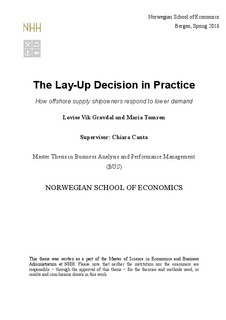The lay-up decision in practice : how offshore supply shipowners respond to lower demand
Master thesis
Permanent lenke
http://hdl.handle.net/11250/2403438Utgivelsesdato
2016Metadata
Vis full innførselSamlinger
- Master Thesis [4372]
Sammendrag
The purpose of this thesis is to improve the understanding of how offshore supply
shipowners adapt to lower demand by putting ships in lay-up. We have examined how day
rates affect lay-up levels, and sought to explain other factors than day rates that might impact
the lay-up decision. We have also looked at how specific vessel characteristics impact the
likelihood that a given vessel will be laid up.
We have used both a qualitative and an empirical approach in our research. In the qualitative
part, we have interviewed seven Norwegian offshore supply shipowners that operate
Platform Supply Vessels (PSV) and/or Anchor Handling Tug Supply (AHTS) vessels in the
North Sea. We have found that in addition to using lay-up to reduce costs, the shipowners
see the opportunity to reduce supply as a main motivation for laying up vessels. They
achieve this by coordinating lay-up levels and thus engage in tacit collusion.
Furthermore, we have found that the attractiveness of lay-up depends on the market outlook,
the opportunity to scrap or sell vessels, startup costs for new vessels, vessel deterioration
when in lay-up, and the ability to keep employees and competence in the company.
The qualitative part of our research enabled us to formulate some hypotheses that we tested
empirically using fleet statistics and day rates from the North Sea region. Using OLS, we
found that day rates are negatively correlated with lay-up levels, but that there might be a
time lag in how a reduction in day rates leads to an increase in laid up vessels.
Using logistic regression, we found that vessel age had some negative correlation with layup
levels, though the correlation was not strong. High capacity as measured by clear deck
area for PSVs had a significant, negative correlation with the likelihood of lay-up. Bollard
pull had a significant, negative correlation with the likelihood of lay-up for AHTSs.
